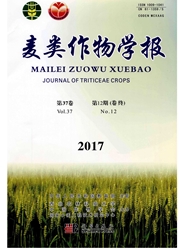

 中文摘要:
中文摘要:
为了解淹水条件下小麦根通气组织形成的细胞学特点和活性氧(Reactive oxygen species,ROS)在通气组织形成中的作用,以高度耐湿的华麦8号幼苗为材料进行淹水处理,在显微水平上系统地观察了通气组织的形成过程,在分子水平上检测了细胞核DNA的断裂情况,并对ROS的动态变化进行了荧光观察。结果表明:(1)通气组织最先起源于根皮层中部,然后逐渐扩展,到淹水8d时基本形成,淹水60d时更为发达;(2)淹水1.5~48h根皮层出现大量细胞核DNA断裂,且细胞核DNA降解为180~200bp的片段,证明小麦根通气组织的形成过程是根皮层细胞发生细胞程序化死亡(Programmed cell death,PCD)的过程,而且淹水1.5~48h是根皮层细胞死亡高峰期;(3)ROS在细胞核DNA发生断裂前开始积累,在通气组织形成中呈现动态变化。上述结果表明,淹水胁迫下小麦根通气组织形成是一个皮层细胞PCD的过程,并且ROS可能参与介导了PCD的进程。另外,淹水胁迫在前期抑制了次生根的产生,随后又促进了次生根的产生。
 英文摘要:
英文摘要:
In order to investigate the cytological aspects and the roles of reactive oxygen species (ROS) during aerenchyma formation in wheat (Triticum aestivum L. cv. Huamai 8, with high flooding tolerance) roots under waterlogging, the process of aerenchyma formation was systemically observed at micro-level, nuclear DNA fragmentation was detected at molecular level and dynamic changes of ROS were observed using fluorescence microscopy. The results indicted that: (1) aerenchymatous spaces were first created in the middle of the root cortex, then expanded, nearly formed at 8 d after waterlogging, and became more developed at 60 d after waterlogging. (2) DNA fragmentation occurred in many cortical cells during 1.5~ 48 h after waterlogging and the fragmented DNA consisted of multiples of 180~200 bp. It suggested that the cell death in root cortex during aerenchyma formation was a programmed cell death (PCD) process and many root cortical cells underwent a PCD process during 1.5~48 h after waterlogging. (3) ROS accumu- lation occurred before nuclear DNA fragmentation and dynamic changes of ROS were observed during aerenchyma formation. These results suggested that aerenchyma formation in wheat roots under waterlogging was a PCD process of many cortical cells and the PCD process might be mediated by ROS. Moreover, gen eration of adventitious roots was reduced at a few days after waterlogging but enhanced thereafter.
 同期刊论文项目
同期刊论文项目
 同项目期刊论文
同项目期刊论文
 期刊信息
期刊信息
